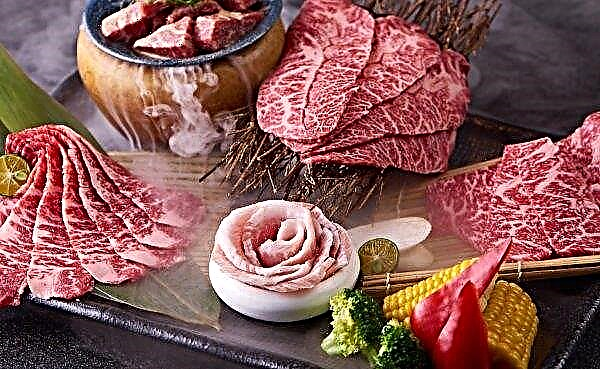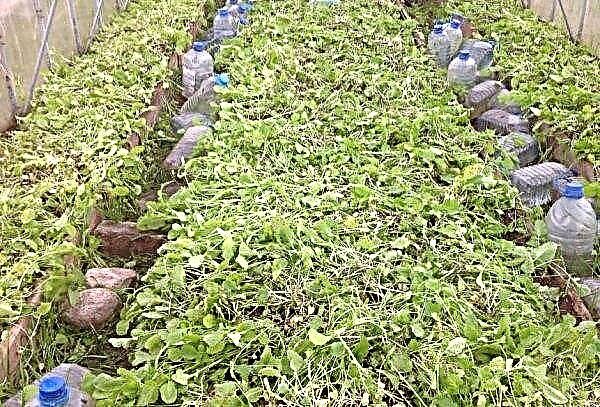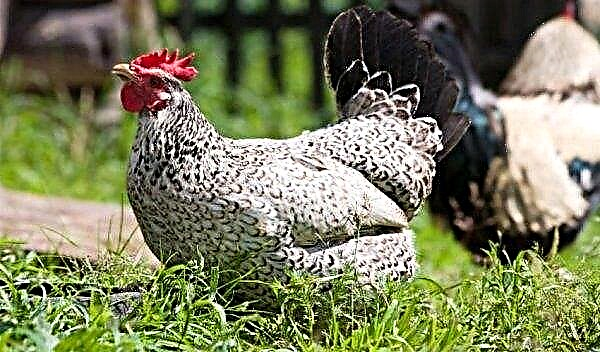Ginger is a herbaceous perennial growing in a tropical climate. The plant is grown commercially for a spicy root. Is it possible to grow a culture in our conditions, at home or in the garden, and how to do it, in detail below.
Is it possible to grow ginger at home
Growing plants in our climate is not uncommon, many gardeners and flower growers already have experience. All that is needed for success is to familiarize yourself in detail with the conditions that culture needs and to ensure them. First of all, it is a microclimate - the birthplace of the Asia plant, where it is warm and humid most of the year.

Depending on the purpose of cultivation: to obtain the root or as a decorative decoration, the gardener needs to study the intricacies of care at different stages of development. Like most tropical plants, ginger needs a dormant period. Subject to the necessary microclimate and care, the flower grower will receive a strong, healthy plant for many years.
Did you know? Young ginger seedlings, the thickness of a pencil, are used in food in many countries. Their taste is similar to mandarin, only with a hint of peppermint.
Root planting
The root, for the sake of which the plant is planted in most cases, develops within 10-12 months. During this period, he is gaining enough spice and pungency. Therefore, planting dates are calculated depending on the desired date of harvest. Typically, the plant begins to germinate in late January, February.

Grade selection
It does not make sense to look for material for planting in nurseries or gardener shops; it is easier to turn your attention to a supermarket. The purchased root must be resilient, dense and uniformly colored. Several kidneys must be present on it, the more the better.
Usually, two types are sold in retail outlets, although in fact, if you look, there is more choice:
Soil and pot
The soil for the plant should be with good throughput, nutritious and slightly acidic. For home preparation, as a basis, you can purchase a finished peat mixture and add sand to it in a ratio of 3: 1.
Important! At the bottom of the pot there should be drainage holes, if they are not there, do it yourself: water stagnation is detrimental to the plant.
Any soil, including from the store, must be decontaminated:
- Shed with potassium permanganate.
- Calcine in the oven at t 100 ° C for half an hour;
- Steam in a water bath for 1-2 hours.
Ginger rhizome is growing rapidly, so the size of the pot should be impressive if you want to grow a medicinal crop or for culinary needs. Since growth is directed more in the horizontal plane, the tank is chosen wide, preferably plastic.

Preparing planting material
The purchased seedling needs to be prepared in high quality: to disinfect and stimulate growth. For disinfection, potassium permanganate is used, a weak pink solution with warm water is prepared, in which the root is soaked whole for 30 minutes.
If you plant a plant right away, then you can wait a long time for activity. You can awaken the buds of planting material by placing it in the moss. The bottom of a suitable container is covered with moist sphagnum and a seedling is placed on a kind of soil. The tank needs to be put in heat, a place near heating appliances is ideal. Sphagnum needs to be regularly moistened, for example, spraying from the spray bottle with warm water. As soon as the buds hatch, you can plant in the ground.

Landing technology
The rhizome before planting is divided into parts, each of which already hatching 2-3 kidneys remains. Slices, in order to prevent infection, are powdered with powdered activated carbon. Landing pattern:
- At the bottom of the tank is placed 2-3 cm of the drainage layer (expanded clay), then the substrate.
- When planting roots, it is not necessary to completely cover with soil. It will be correct to leave the kidneys open: in the light, the sprouts will grow faster.
Video: Planting Ginger Root
Germination conditions
In order for the hatching kidneys to soon produce full-fledged sprouts, an imitation of a greenhouse must be created. Cover the container with seedlings with glass or film, place on the windowsill next to the heater. Ideal conditions for germination - temperature above + 22 ° С.
Healthy, full-fledged stems appear within 2–4 weeks. The greenhouse can be removed, and seedlings sprinkled with soil.
Important! Ventilate and remove condensation regularly so that rot does not occur.
Features of care and maintenance
A grown plant also needs to ensure maximum comfort so that the crop is succulent and most useful.
Microclimate
As mentioned above, ginger is a tropical plant, so the development conditions differ by season. So, the optimal microclimate:
- lighting - partial shade in the summer, the active sun can burn delicate foliage. The daylight hours are 14–16 hours; during a short daylight, artificial lighting with a phytolamp will be needed;
- temperature - spring + 20 ... + 22 ° С, in the summer + 24 ... + 28 ° С, November - January + 5 ... + 15 ° С (rest period). Sudden changes in temperature, drafts are contraindicated. In summer you can keep on the balcony;
- humidity - 80–90%, regular spraying of air near the pot, foliage if necessary, constant circulation of fresh air.

Watering and feeding
Between spring and late fall, until the dormant period begins, ginger needs regular watering. Do not zeal and fill the soil, otherwise the tubers will rot. You can focus on the condition of the soil - always a little damp. The approximate interval between watering is 2–4 days. Since the beginning of November, watering has been gradually reduced so that there is no sharp drop. During the dormant period, the plant does not need to be watered, just spray the soil from the spray gun.

Fertilize the culture begin 2-3 weeks after the appearance of strong stems. Time of active top dressing March - October, interval 14–20 days. Before the summer season, nitrogen compounds are used, after which they switch to complexes with potassium.
Did you know? Ginger in land plays the role of an antiseptic: its active components destroy the bacteria that are found in raw fish.
As a nitrogen top dressing, mullein infusion diluted with 1:20 water is used. Organic fertilizers are not always available at home, so instead of them they take urea 1 g / 2.5 l of water to water several plants. As potash, kalimagnesia, potassium sulfate 2.5 g / 3 l of water or wood ash 50 g / 2 l of water are used.

Pruning and soil care
When ginger is grown for the root, it is advisable to prune its green shoots. Thus, all the juices and nutrients absorbed by the culture will be sent to the tuber. Pinch and thin out the ground part as the shoots grow.
A prerequisite is loosening the soil, which saturates the tubers with oxygen. Without air access, the taste of the future crop will be fresh. The procedure is carried out one hour after watering, once a week.

Harvesting
Ginger needs to grow to a full crop for at least 10 months. In this case, it will be juicy, aromatic and rich. If the plant is grown as a medicinal plant, then it needs to be given even more time to ripen.
Yellowed and withered leaves will serve as a signal that it is time to harvest. The collection process begins with the removal of the ground part. Then the root system is carefully dug up and removed from the soil. Tubers are washed from the adhering earth, if desired, cleaned with a brush, dried.

Growing Ginger at Home for Flowering
In order to bloom, a houseplant needs special conditions, it will take about 3 years to wait. But the result is worth it: a large bright inflorescence is not inferior in beauty to exquisite decorative plants. The waiting time is explained by such a feature: the peduncle is formed not from a planted tuber, but from a kidney that has matured and gives healthy offspring.
Stimulation of ground shoots
Culture sharply reacts to all manipulations carried out with it. If during the formation of a bud bearing a peduncle, you do not add watering, fertilizer, change the lighting or the place of detention, another tuber will appear instead of a flower.
 A stimulus for pasting a peduncle instead of a tuber will be a narrow pot. The culture simply will not have room for the development and extension of additional root processes. Naturally, pruning of shoots is not carried out
A stimulus for pasting a peduncle instead of a tuber will be a narrow pot. The culture simply will not have room for the development and extension of additional root processes. Naturally, pruning of shoots is not carried out
Conditions at rest
Growing a long-term culture for decorative purposes, we must not forget about the rest period. At this time, you need to provide gentle care, so that in spring the greens actively go to growth. The temperature is lowered gradually: a couple of degrees a day to + 5 ° C.
Lighting at this time is not necessary, as well as top dressing. Watering as such is not carried out, but care must be taken that the soil in the pot does not completely dry out. If you ensure a good change of seasons - to bloom.
Important! You can’t move the pot to another place when the flower stalk has appeared, ginger can “change your mind about blooming”.
Transplanting into open ground or a greenhouse: the difference
The climatic conditions of our country are not suitable for culture, on open ground it is grown only as an annual. A transplant of a seedling in open ground is carried out in May, when the soil is sufficiently warmed up. Our winters, even in the southern regions, are too harsh. The solution is to to grow a culture in a pot, for the summer, taking it out to the garden and digging it in together with the container, for the winter to put it back into the house.
Many cottages today have heated greenhouses for year-round cultivation of vegetables and herbs. There is a huge advantage: you can adjust the temperature and humidity, creating the conditions necessary for the culture.

In the greenhouse or in the garden you need to prepare the soil, the following components are taken, taken in equal parts:
- turf land;
- sheet earth;
- sand;
- peat.
The soil must be disinfected: you can shed boiling water or a solution of potassium permanganate. Further care is the same as described above: watering, fertilizing and caring for the soil.
Disease and Pest Prevention
Both the indoor flower and the greenhouse or from an open garden bed require preventive treatments. Despite the excellent immunity, the plant can be attacked by fungito prevent their occurrence, treatment with fungicides is needed. This can be a purchased drug, of a biological type, since the procedures are carried out every 3-4 weeks, for example, Fitosporin or Bactofit.
Most insects bypass ginger: Its volatile and citrus scare scare them away. According to some reviews, shoots are exposed spider mite attacks. The ideal habitat for the insect is dry, stagnant air, so compliance with the rules of care will be the best prevention. In case of a tick attack, 2 ml / 1 L of water is destroyed by spraying with the Akarin insecticide.

It is not difficult to grow your own crop of a spicy exotic plant, it is harder to achieve its flowering. However, with patience and compliance with all rules and procedures, this is possible.












